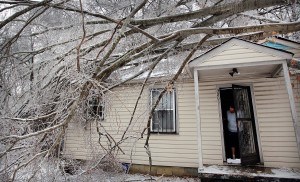 As New England confronts record snowfall and the risks that come with it, an open question remains whether property/casualty insurance carriers who do the bulk of their business in the region can handle the expected surge in claims demands. A new A.M. Best report warns that small regional carriers in particular may face problems.
As New England confronts record snowfall and the risks that come with it, an open question remains whether property/casualty insurance carriers who do the bulk of their business in the region can handle the expected surge in claims demands. A new A.M. Best report warns that small regional carriers in particular may face problems.
Small regional carriers risk exceeding their catastrophe reinsurance retention as they sort through winter claims, according to the report.
“It is too early to determine if insurers in the region impacted by the recent snow storms will exceed their catastrophe reinsurance retention,” the A.M. Best report reads. “It should be noted that small geographically concentrated insurers are more likely to exceed the retention on their catastrophe programs.”
With that possibility in play, the report adds “it is questionable whether reinsurance recoveries will provide significant profitability relief to these insurers.”
At the same time, the A.M. Best report asserts: “Capitalization levels for most carriers in the New England region have increased over the past several years and are sufficient to withstand losses generated by these winter storms.”
The A.M. Best report does not name specific small carriers with which it has storm-related concerns. But it lists the 20 P/C carriers with the greatest concentrations of business in New England as of 2013. Of those, seven had 80 percent or more of their total direct written premiums coming from the region.
They include Plymouth Rock Companies (95.3 percent) Barnstable Group (88.2 percent); Concord Group Insurance Pool (88.2 percent); Safety Group (82.8 percent); Co-operative Insurance Companies (80.8 percent), NLC Insurance Companies Pool (80.7 percent), and Quincy Mutual Group (79.7 percent). Each has a policyholder surplus that varies widely per company from eight to nine figures.
Rick Decker, an A.M. Best vice president and study co-author, did not comment on concerns about specific companies.
In an interview with Carrier Management, he clarified the parameters of the report, noting: “A lot of the companies here, when we say regional companies, may not be that small, but the companies (outlined in the report) might write in other parts of the country as well.”
He said that companies that write throughout the U.S. will likely see their New England underwriting results reflect “some deterioration and impact of the weather that this article speaks to.”
“We will be interested in seeing how they handle all the claims” and the effectiveness of the risk management strategies they have implemented over many years, Decker said.
Carriers that do business in New England have always been concerned about weather exposures, Decker said, but he noted that companies have worked “over many years to mitigate the impact of storms like this.”
“And that is kind of what our article is about … it is testing the activities and strategies that companies have put in place.”
He emphasized that A.M. Best is not overly worried about this issue, because “capitalization has been strong for the personal lines market, generally.” The New England storm impact, he said, will likely show up in profitability, and some companies’ combined loss ratios.
“Any company that writes business out there we will ask what impact these storms did have,” Decker said. “Losses will affect both commercial lines risk and personal lines property writers. You can write a commercial lines risk that has a large property exposure—it could be a car dealership as example—that affects both personal lines and commercial property.”
He added: “The roof collapse is the cause of loss that we expect to hear the most about.”
Source: A.M. Best





















 2025 Underwriting Profit and ‘Shop-a-Palooza’ Predicted for Auto Insurance
2025 Underwriting Profit and ‘Shop-a-Palooza’ Predicted for Auto Insurance  Mercury General Wildfire Losses Will Hit Reinsurance Cover. One Event?
Mercury General Wildfire Losses Will Hit Reinsurance Cover. One Event?  States Push Changes to Driver, Auto Insurance Requirements in 2025
States Push Changes to Driver, Auto Insurance Requirements in 2025  First 2025 Atlantic Hurricane Season Forecasts 7 Named Storms
First 2025 Atlantic Hurricane Season Forecasts 7 Named Storms 


